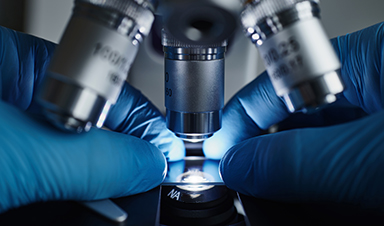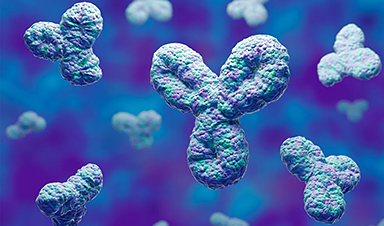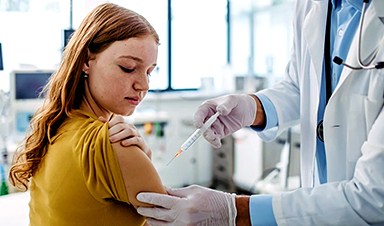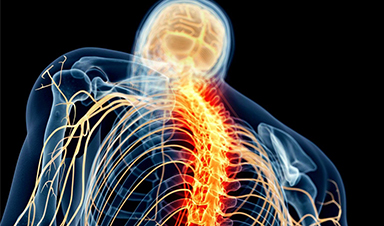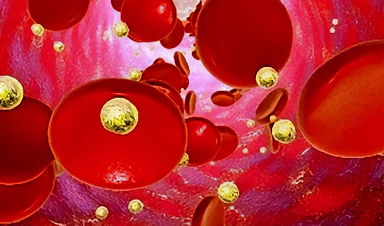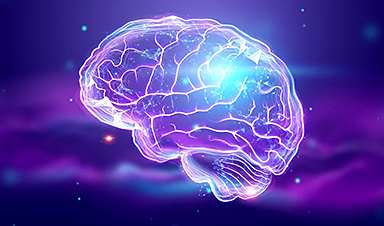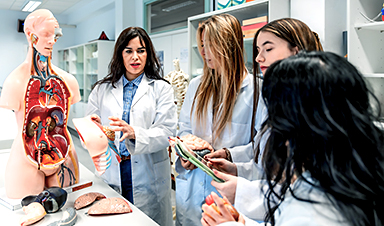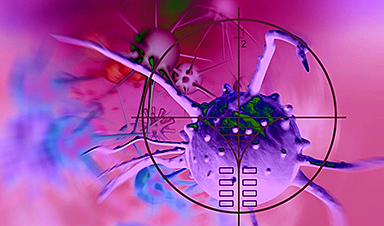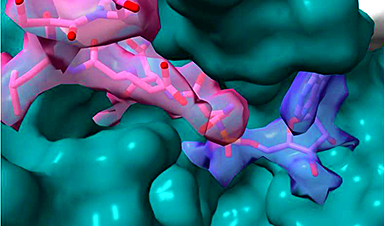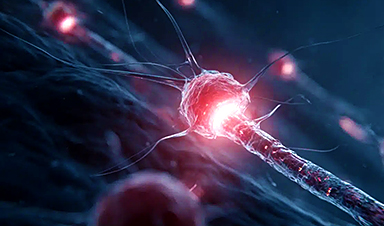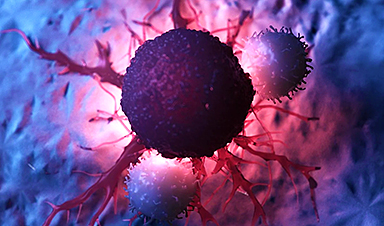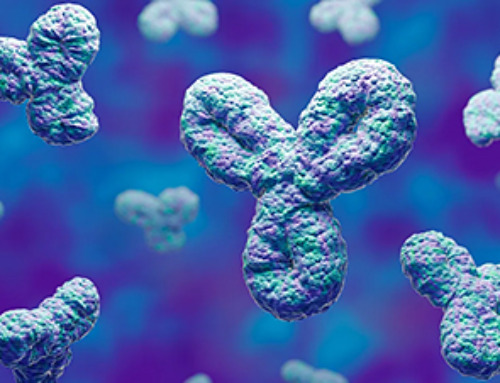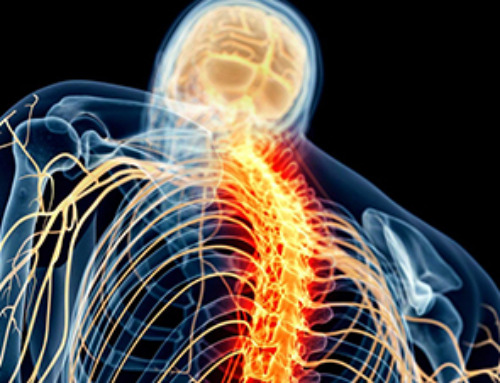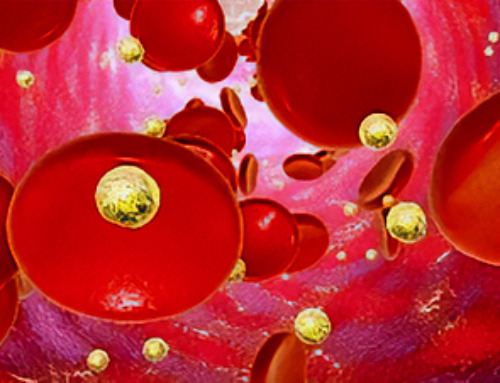| Gold nanoparticles are minuscule particles made of gold. From drug and gene delivery to photothermal and photodynamic therapies to screening and diagnostic tests to radiation therapy, X-ray imaging and CT scans, these small particles engineered from the precious metal serve a variety of functions in the biomedical field and hold the potential for future applications in medicine. | |
| Konstantin Sokolov, Ph.D., professor of Imaging Physics, and Aaron Schwartz-Duval, Ph.D., T32 Cancer Nanotech postdoctoral fellow, recently published a paper about gold nanoparticles’ potential for cancer therapy (Advanced Science, “Prospecting Cellular Gold Nanoparticle Biomineralization as a Viable Alternative to Prefabricated Gold Nanoparticles”). Here, they discuss gold nanoparticles, how they work and what’s next in the field. | |
What are gold nanoparticles? |
|
| Sokolov: Gold nanoparticles are very, very tiny specks of gold — the size of about 1,000th of the width of a human hair. In water suspension, they usually have wonderful bright red colors. | |
| People have been unwittingly using gold particles in art for millennia, such as the 4th century Roman glass Lycurgus cup. But it wasn’t until the late 1980s and early 1990s when people actually started to realize that these particles also have potential for medical imaging and therapeutic applications. In fact, gold particles are widely used in a range of diagnostics assays. The most common use are pregnancy tests. Those bright lines that you see on urine pregnancy tests are produced by a gold nanoparticle solution. A more recent example is multiple rapid COVID-19 tests, which were also based on this very vivid color of gold particles. | |
How do gold nanoparticles work to treat cancer? |
|
| Sokolov: There have been significant efforts, including at MD Anderson, to use gold nanoparticles for cancer therapy. One has been a collaboration between Rice University and MD Anderson on using gold nanoshells for photothermal cancer therapy. Another example uses cancer-targeted gold nanoparticles to enhance radiation dose delivery specifically to cancer cells. However, there are very significant physical barriers in delivery of even very small gold nanoparticles inside the tumor because human tissues are generally very dense. One can appreciate this density by touching skin and feeling the underlying tissue. So, even these tiny objects cannot penetrate deep enough into the tumor and cannot reach all cancer cells. But now we are rethinking how we can overcome this limitation by repurposing a well-known geology phenomenon of gold biomineralization for cancer therapy applications. | |
What is gold nanoparticle biomineralization? How does it work? |
|
| Schwartz-Duval: When we think about typical mineralization, we think about rock formations or ceramics in high heat, high pressure environments. Biomineralization, on the other hand, is when those formations occur outside of those environments. This is orchestrated by living organisms like cells. In the biomedical realm, we tend to think about bones and stones. Bones and kidney stones are both calcium biominerals. | |
| With gold, it’s not really obvious that would happen as well because gold is a rare earth metal. However, living organisms are able to process gold in a cyclic manner from a soluble form to a crystalline form. That’s actually related to how gold nuggets are formed in nature. When microorganisms, like bacteria, are near gold or interacting with gold, which is normally at a very low concentration in soil, these cells will dissolve that gold and concentrate it, forming gold nuggets. They can also form gold nanoparticles. | |
Can gold nanoparticles form in the body? |
|
| Schwartz-Duval: Yes, they can. This process can happen in mammalian cells with gold through biomineralization. Studies have shown that biomineralization of gold particles can occur with every kind of cell tissue source. We have found that it occurs more with cancer than in normal tissue. Potentially, we could apply this strategy for any cancer that would benefit from radiotherapy. | |
| Humans have been obsessed with gold throughout history for either perceived or actual medicinal properties. Now we make gold nanoparticles for therapeutics. In the 1920s, there were people developing gold salts — ionic chemical compounds of gold — to treat tuberculosis. While these compounds weren’t effective against tuberculosis, it was discovered that they were sometimes effective in relieving inflammation in people with rheumatoid arthritis. | |
| Interestingly, a prolonged treatment with high quantities of gold salts on a rare occasion resulted in a mild condition of “blue” skin appearance – Chrysiasis that later was shown to be due to formation of gold nanoparticles in skin macrophages. This is the evidence of the possibility of gold biomineralization in a human body. | |
| Silver therapeutics or gold salt drugs were used in the clinic before researchers realized a clinical potential of gold nanoparticles. However, there was no time overlap in these two developments. Gold salts fell out of use with development of a better understanding of rheumatoid arthritis and an emergence of more advanced treatments. But we believe that there is still great potential in this area of research. | |
Do gold salts have direct therapeutic benefits? |
|
| Sokolov: Gold salts have been shown to suppress inflammation. We hypothesize that they can also normalize the tumor’s local microenvironment. Essentially, they might suppress the pro-inflammatory tumor environment that right now is known to be one of the main drivers of cancer progression. Importantly, gold salt treatment enables formation of gold nanoparticles that as we know can enhance therapeutic interventions by increasing either heat or radiation dose delivered to cancer cells. | |
How can growing gold nanoparticles in patients help therapeutic interventions? |
|
| Sokolov: Our research is focused on using exceedingly tiny gold atoms to overcome physical delivery barriers that we discussed at the beginning and to uniformly deliver gold to all cancer cells in the tumor. Think about it: gold nanoparticles are approximately 1/1000th of a human hair, but gold atoms are more than 100 times smaller than gold nanoparticles or just 1/100,000th of a human hair. This is incredibly small! In fact, it is the ultimately small size for a drug — just a single atom! | |
| So, gold atoms or ions can easily penetrate any human tissue like any other ion that is involved in our physiology. The trick is that cancer cells accumulate these gold atoms — through still not fully understood mechanisms – that is followed by intracellular gold biomineralization to form gold nanoparticles. Then, we can use these intracellular gold nanoparticles for highly efficient enhancement of photothermal or radiation therapies. | |
| During photothermal therapy an external light is used to illuminate tumor, the light is then absorbed by gold nanoparticles generating excessive heat that kills the cancer cells. | |
| We can do the same with radiation therapy. This is even more exciting because radiation can penetrate anywhere inside the body and is one of the most widely used types of cancer treatment. When radiation interacts with these gold nanoparticles, there is a secondary electron shower. This means there is a local dose enhancement of radiation. | |
| As a result, you can apply less radiation to the tissue, but the nanoparticles will amplify the effects of the radiation to kill the cancer cells and to spare the surrounding normal tissues. The effect of the local radiation dose enhancement by gold nanoparticles is called radiosensitization. That’s what we call a direct hit approach. We are very fortunate to collaborate with pioneers in this field, including MD Anderson radiation physicist Sang Cho, Ph.D. | |
| Schwartz-Duval: The initial data also showed that the gold treatments have a secondary effect as well. After our gold treatment was applied, we saw that it suppressed pro-cancer signaling, toward normal, within the network of communication between different cells. When cancer cells communicate, the signals they send to other cells can transform those cells to cancer promoting states, and when this spirals out of control, the cancer grows more quickly and becomes malignant. However, intracellular gold biomineralization somehow disrupts this pro-cancer transformation indicating that it can commandeer the signaling network. We believe that this phenomenon could potentially extent toward new sites of cancer growth such as metastatic formations. Along with Dr. Sokolov, I am currently working with MD Anderson immunologist Michael Curran, Ph.D., to explore this potential. | |
What’s next for your research in gold nanoparticle biomineralization? |
|
| Sokolov: We are currently working with a team of clinicians and basic scientists to evaluate the radiation effects in two very important organ sites. In the next few years, we plan to conduct further studies evaluating the therapeutic efficacy of gold salt treatments for pancreatic and thyroid cancers, which are both inoperable and very devastating cancers. We’re working with pancreatic cancer surgeon Michael Kim, M.D., on the pancreatic cancer one, and with head and neck surgeon Stephen Lai, M.D., Ph.D., on the thyroid cancer one. | |
| We hope that these studies will provide further evidence of therapeutic efficiency of this new radiation treatment strategy that can ultimately lead to more efficient treatment options for cancer patients affected by these deadly cancers. |
News
Specially engineered antibody delivers RNA therapy to treatment-resistant tumors
Elias Quijano, PhD; Diana Martinez-Saucedo, PhD; Zaira Ianniello, PhD; and Natasha Pinto-Medici, PhD, there are 25 other contributors, most from Yale's Department of Therapeutic Radiology and from the departments of genetics, molecular biophysics and [...]
Vaccinated women face fewer cervical cancer risks
New data from Denmark shows the HPV vaccine’s powerful long-term impact, while also revealing why cervical cancer screening is still essential. A Danish study published in the journal Eurosurveillance reports that women who received the human [...]
3D-printed implant offers a potential new route to repair spinal cord injuries
A research team at RCSI University of Medicine and Health Sciences has developed a 3-D printed implant to deliver electrical stimulation to injured areas of the spinal cord, offering a potential new route to [...]
Nanocrystals Carrying Radioisotopes Offer New Hope for Cancer Treatment
The Science Scientists have developed tiny nanocrystal particles made up of isotopes of the elements lanthanum, vanadium, and oxygen for use in treating cancer. These crystals are smaller than many microbes and can carry isotopes of [...]
New Once-a-Week Shot Promises Life-Changing Relief for Parkinson’s Patients
A once-a-week shot from Australian scientists could spare people with Parkinson’s the grind of taking pills several times a day. The tiny, biodegradable gel sits under the skin and releases steady doses of two [...]
Weekly injectable drug offers hope for Parkinson’s patients
A new weekly injectable drug could transform the lives of more than eight million people living with Parkinson's disease, potentially replacing the need for multiple daily tablets. Scientists from the University of South Australia [...]
Most Plastic in the Ocean Is Invisible—And Deadly
Nanoplastics—particles smaller than a human hair—can pass through cell walls and enter the food web. New research suggest 27 million metric tons of nanoplastics are spread across just the top layer of the North [...]
Repurposed drugs could calm the immune system’s response to nanomedicine
An international study led by researchers at the University of Colorado Anschutz Medical Campus has identified a promising strategy to enhance the safety of nanomedicines, advanced therapies often used in cancer and vaccine treatments, [...]
Nano-Enhanced Hydrogel Strategies for Cartilage Repair
A recent article in Engineering describes the development of a protein-based nanocomposite hydrogel designed to deliver two therapeutic agents—dexamethasone (Dex) and kartogenin (KGN)—to support cartilage repair. The hydrogel is engineered to modulate immune responses and promote [...]
New Cancer Drug Blocks Tumors Without Debilitating Side Effects
A new drug targets RAS-PI3Kα pathways without harmful side effects. It was developed using high-performance computing and AI. A new cancer drug candidate, developed through a collaboration between Lawrence Livermore National Laboratory (LLNL), BridgeBio Oncology [...]
Scientists Are Pretty Close to Replicating the First Thing That Ever Lived
For 400 million years, a leading hypothesis claims, Earth was an “RNA World,” meaning that life must’ve first replicated from RNA before the arrival of proteins and DNA. Unfortunately, scientists have failed to find [...]
Why ‘Peniaphobia’ Is Exploding Among Young People (And Why We Should Be Concerned)
An insidious illness is taking hold among a growing proportion of young people. Little known to the general public, peniaphobia—the fear of becoming poor—is gaining ground among teens and young adults. Discover the causes [...]
Team finds flawed data in recent study relevant to coronavirus antiviral development
The COVID pandemic illustrated how urgently we need antiviral medications capable of treating coronavirus infections. To aid this effort, researchers quickly homed in on part of SARS-CoV-2's molecular structure known as the NiRAN domain—an [...]
Drug-Coated Neural Implants Reduce Immune Rejection
Summary: A new study shows that coating neural prosthetic implants with the anti-inflammatory drug dexamethasone helps reduce the body’s immune response and scar tissue formation. This strategy enhances the long-term performance and stability of electrodes [...]
Scientists discover cancer-fighting bacteria that ‘soak up’ forever chemicals in the body
A family of healthy bacteria may help 'soak up' toxic forever chemicals in the body, warding off their cancerous effects. Forever chemicals, also known as PFAS (per- and polyfluoroalkyl substances), are toxic chemicals that [...]
Johns Hopkins Researchers Uncover a New Way To Kill Cancer Cells
A new study reveals that blocking ribosomal RNA production rewires cancer cell behavior and could help treat genetically unstable tumors. Researchers at the Johns Hopkins Kimmel Cancer Center and the Department of Radiation Oncology and Molecular [...]
